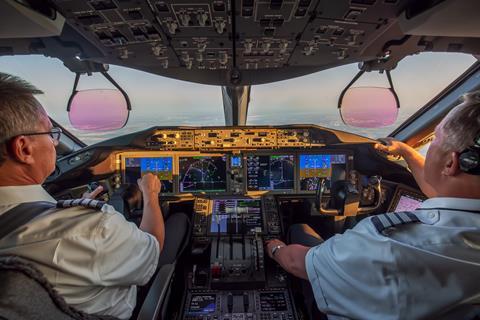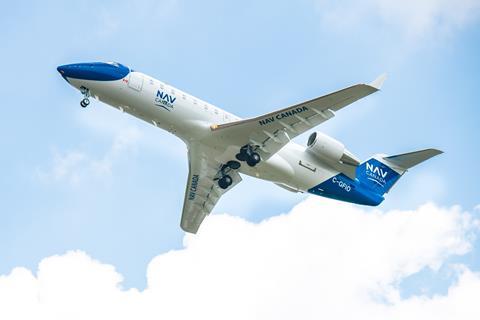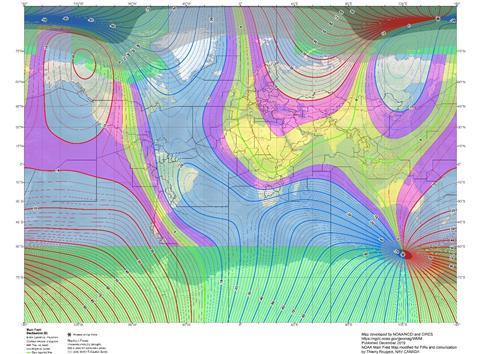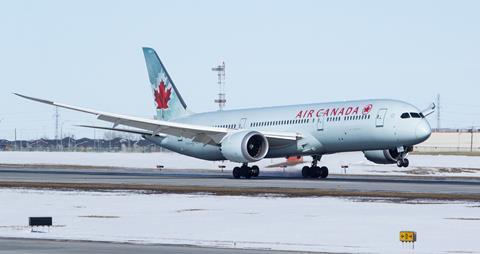While professional mariners stopped using the earth’s magnetic field as their primary directional reference some 50 years ago, civil aviation did not, because at that time accurate inertial navigation systems (INS) were too heavy and bulky for aircraft use.
Today, however, navigation by global navigation satellite systems (GNSS) – backed up by ring laser gyro-stabilised INS/attitude and heading reference system platforms, radio beacons and air traffic control surveillance using multiple technologies – means that aviation has no real need to use a magnetic reference.

The debate about changing from Magnetic to True navigation is now moving towards how to change, and when, with March 2030 as the proposed date.
Modern civil and military aircraft have the capability to fly to a True North reference at the push of a button: the flight management system (FMS) is designed to identify True North at start up, and when a magnetic reference is required it is computed from True by applying local magnetic variation via embedded look-up tables.
With the ubiquitous use of GNSS, impressive capability of modern inertial reference systems, and the steady decommissioning worldwide of surface-based radio navigation aids, the decision to rely on the earth’s constantly changing magnetic field is increasingly hard to justify.
The International Association of Institutes of Navigation (IAIN), which has meticulously studied all the issues, comments: “The biggest single problem in trying to implement this change worldwide would be inertia – the large number of countries involved and the difficulty of finding the will to all change at once.”
To work out how best to overcome this inertia, the IAIN set up a specialist working group, the Aviation Heading Reference Transition Action Group (AHRTAG), which has been meeting monthly since early 2021.
A Canadian-led multinational team of navigation experts from Australia, France, the Netherlands, the UK and the USA, the AHRTAG is chaired by Anthony MacKay, Nav Canada’s director of operational safety. The group includes representatives from several national aviation authorities (NAAs), major aircraft manufacturers, pilot associations, and also the commercial air navigation charting and aviation information provider Jeppesen.
UPDATING SYSTEMS
The migration of the geographic magnetic poles has accelerated in recent years, adding to the relentless task of updating systems and distributing the associated flight information.
The AHRTAG points out that updating aircraft declination look-up tables is a specialist and expensive maintenance activity that has no effect on the way an aircraft derives its directional information. It merely ensures the result is displayed as a magnetic value that is normally less accurate than the originally determined True heading.
And, if a future variation shift is sufficient to affect airport assets – like runway and taxiway signage and markings, plus instrument procedures, landing aids documentation, and FMS coding – at a major hub, the cost can top $20-30 million.
Moving from Magnetic to True reference is no more challenging than, for example, the periodic task of re-orientating VHF omnidirectional radio range (VOR) and TACAN radio navigation beacons for local magnetic variation changes. Across the industry, staff have the necessary skills and knowledge to make the move.
Canada is now actively concentrating on implementing the change: it already references True North in nearly half of its airspace because of its proximity to the (moving) surface location of the magnetic North pole.
Aviators in the northern Canadian airspace have employed tried and tested procedures for both traditional radio navigation beacons and all types of performance-based navigation (PBN) systems. The country’s air navigation service provider (ANSP), Nav Canada, working with the AHRTAG, has almost completed drawing up its concept of operations (CONOPS) for the switch.
ICAO has shown great interest in Nav Canada’s “Mag2True” work, particularly since Canada presented a White Paper on the subject to its 13th Air Navigation Conference in 2018, seeking agreement and proposing adoption by 2030. The conference agreed that a further study of Mag2True’s cost/benefit should go ahead.
IMPLEMENTATION PLANS
The agency is hoping to be presented with “ready-made SARPS [standards and recommended practices] and implementation plans to move issues forward”. Canada was due to present a formal Mag2True update during ICAO’s high-level conference in October 2021, and a presentation by the AHRTAG on True North is on the agenda of ICAO’s European PBN Task Force/Navigation Steering Group meeting in early December.
Assisting ICAO to overcome global inertia might work like this: one state – Canada – unilaterally files a difference from international heading reference standards, successfully transitions to True North within its entire airspace, and demonstrates that the new system works.
The US Federal Aviation Administration (FAA) is also warming to the idea. According to FAA sources, the body’s thinking is moving in much the same direction as Canada’s, recognising that pilots are accustomed to operating despite differences that come into play at a border. For example, most of the world measures flight altitude in feet, but China, the Russian Federation and a few other states use the metric system.
To sceptics reluctant to abandon any heading reference system – especially one as familiar as the magnetic compass – despite the existence of proven alternatives, AHRTAG member Dai Whittingham points out that modern aviation rulemaking is risk-based. Risk can never be reduced to zero, but the introduction of any new system must be proven to be extremely low-risk.
Comparisons between the existing and proposed regimes are inevitable, but Whittingham – who is also chief executive of the UK Flight Safety Committee – believes it is wise when playing “what if” games with the proposed system to admit that the existing one has its faults, and to enumerate those.
Meanwhile, the AHRTAG, which continually seeks feedback from all parts of the industry, has been able to report that anticipated resistance to change in sectors like general aviation (GA) is softening to the point of disappearance, especially as GA is a now big user of GNSS systems, whether employing installed avionics, hand-held GPS devices specified for aviation, or tablet-computer electronic flight bags.
PROPOSED CHANGEOVER
Similarly, airline pilot associations and the airlines themselves seem generally happy about the proposed changeover, for which the accepted shorthand has become Mag2True.
Canada’s draft CONOPS offers a good indication of how the Mag2True task might be rolled out. There are three aviation arenas affected: aircraft operations, which implies inclusion of the airlines and original equipment manufacturers; aerodromes; and, finally, ANSPs. Overseeing this will be the NAAs, with ICAO keeping an eye on standardisation.
Questions remain about timing, though. Should the switch to True be global and simultaneously made on a single date, or managed regionally, or by hemisphere?
Canada’s proposed 2030 transition year would require NAAs, ANSPs and states to trigger the change. If an implementation date can be agreed, it would be entered in ICAO’s Aeronautical Information Regulation and Control calendar in the normal way for promulgating changes.
The draft CONOPS proposes that, in the six to eight months ahead of Mag2True adoption, the state would not action any changes to its aeronautical information publication (AIP), freezing all but emergency changes to procedures. The only changes promulgated would be those needed to convert Magnetic to True.
During this time, the state would also need to enact a plan to rotate its VORs and ensure that surveillance systems and air traffic controllers are all ready for the change.
All states have a procedure in place for crews to adjust VOR radials (+/- bearing values) until publication of the corrected values once the VOR is rotated and calibrated. The Mag2True transition date would be the last such rotation, because once set to “0” – or True – they would never need to be adjusted again.
The ARINC 424 database that the state AIP feeds could be maintained with its current structure, with all magnetic variation values being set to “0”. Jeppesen has successfully tested this conversion method, demonstrating it via a Bombardier CRJ200 flight test conducted with Nav Canada.

The draft CONOPS proposes a way of staging the changeover. For those regions of the world where existing magnetic declination is small, VORs could safely be aligned today to within +/-4° of True North – a move that would still fall within the current tolerance of many states.
Canada uses +/-2° as a tolerance, but given the amount of magnetic variation change from coast to coast, the nation would have to rotate its VORs anyway.
For many aerodromes in areas where the variation is less than +/-10° of True North, no immediate change to runway numbering – or to airport manuals – would be required. Indeed, the draft CONOPS notes, it could be argued that no change would ever be required.
Change would have to be more carefully managed in other areas, which are predominantly either oceanic, or cover Brazil, Canada, Russia and the USA: the states most accustomed to having to implement updated variation values.

Since most carriers already use True tracks during oceanic operations, there would be little or no change for the ANSPs managing oceanic areas, or those bordering them.
Admittedly, there would be other small but important details that would need attending to. For example, airport air traffic services would need to ensure that adjusted vector headings for common procedures were included in any memory aids for controllers.
With the exception of NDB approaches and vector headings, most other conventional and PBN procedures are now track-based anyway, allowing correct tracks over the ground to continue during the change period. However, the heading error would appear as apparent wind drift, which could be misleading to aircrew.
Crew confusion also could arise from changes to routines, especially to oft-flown procedures. However, there is arguably already plenty of potential for confusion in a system that continues to use two heading references, one of which is variable.
Examples exist of repeated heading reference problems that are endemic to the existing magnetic navigation system.
In one incident, a Boeing 757’s pilots were flying a CAT II approach to runway 29 at St John’s, Newfoundland, Canada. When it intercepted the localizer, the aircraft rolled back and forth across the localiser trying to maintain the centreline. The cause was that the magnetic variation (mag var) of the published procedure differed from the out-of-date mag var tables in the aircraft’s inertial reference unit (IRU).
MISALIGNED IMAGE
Also in Canada, a crew was testing the CAT III approach to Calgary’s new runway 17L, when they observed that the synthetic runway image in the head-up guidance system was misaligned by 7° versus the actual runway. The crew ran the same test again after the aircraft had been fitted with new IRUs for which the tables had been updated from 2010 to 2015 information, and the synthetic and actual world aligned perfectly.

In the months that followed this event, many crews conducting autolands on 17R at Calgary reported their aircraft moving off the centreline when transitioning to autonomous flare mode. In all cases, their aircraft were found to have out-of-date mag var tables in their IRUs.
Canada’s CONOPS for 2030 offers a route to modernity and the avoidance of needless costs for the aviation industry. Moreover, the case for embracing the Mag2True shift is likely to become unstoppable as the numbers of remotely piloted air systems and autonomous platforms – which navigate in True – increase globally.
As such, why would aviation want to persist with two systems of reference?